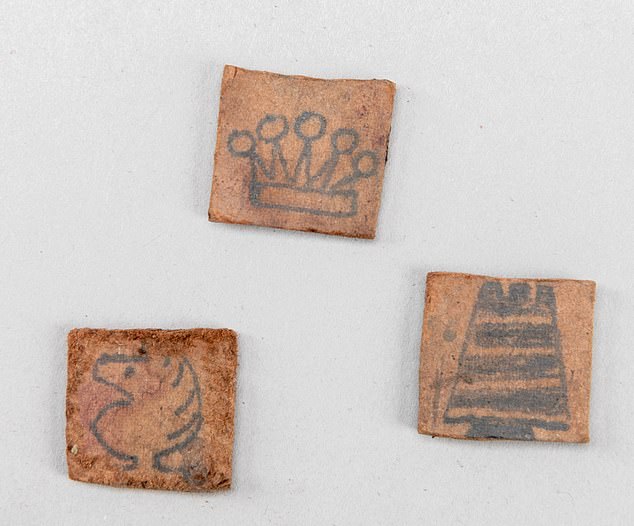- They were discovered during renovation work on the first floor of the building
- The chess pieces will be featured in an upcoming exhibition on the lives of prisoners
<!–
<!–
<!– <!–
<!–
<!–
<!–
More than 30 handmade chess pieces have been found hidden beneath the floor of the notorious Auschwitz extermination camp in Nazi Germany.
The 35 cardboard squares with hand-drawn characters were discovered during renovation work on the first floor of the former prisoner block 8 of the Auschwitz I camp.
Elżbieta Cajzer, head of collections at the Auschwitz Museum, said: “Several drawings can be a little blurry, but the images of rooks, pawns, bishops and knights are always easy to distinguish.
“However, the whole is incomplete and some boxes no longer bear any trace of the drawing.
“Our evaluation shows that the objects are in a good state of conservation.

More than 30 handmade chess pieces found hidden under Auschwitz floor


“The chess pieces were made from prefabricated cardboard in a “relatively primitive” way.
“They will now be subject to conservation treatment.”
She added: “The discovered chess pieces are unique in the sense that they were made from pre-fabricated cardboard in a relatively primitive way.
“We assume the emphasis was not on aesthetic qualities but on functionality, easy portability and quick concealment.”
Established in April 1940 to hold Polish prisoners following Nazi Germany’s invasion of Poland, by the time of its liberation in January 1945 the camp had become the largest killing machine in history.
More than a million people, mostly Jews, were executed, beaten, tortured, starved or gassed to death, while countless others died of disease or malnutrition.
Magdalena Urbaniak, from the Auschwitz Museum, said that to escape the harsh realities of the camp, prisoners tried to spend their free time playing games.


Newly discovered chess pieces to be showcased in exhibition on prisoners’ lives
She said: “Chess and cards were popular games that people could make themselves from illegally acquired pieces of cardboard or wood.
“The camp prisoners viewed their mental activities as a respite from the brutal reality of the camp.
“The objects necessary for the game were most often produced illegally by the prisoners.
“Wood, paper and, more rarely, other available materials, such as breadcrumbs, were used as materials.
“Some gaming accessories reached the camp prisoners illegally from luggage confiscated from Jewish victims. »
Survivor Jan Dziopek, who worked as a storekeeper in the camp carpentry shop where he made chess pieces and boxes, recalls: “I received a lot of orders, even from the SS.
“However, I was reluctant to fill them out. Nevertheless, I had to honor their orders because, under the guise of working for them, I could respond to the demands of my colleagues, who paid me with bread rations or camp soup.


The 35 cardboard squares with hand-drawn characters were discovered during renovation work on the first floor of the former prisoner block 8 of the Auschwitz I camp.
“My colleagues in the kitchens and various warehouses bought these items from me, as they had no difficulty in obtaining food.
“I won’t go into detail about how many times and how many lashes I received for this.
“Since I couldn’t tinker around in the warehouse for fear of getting caught, I created a secret hiding place in the attic and transferred all the necessary tools from the warehouse. I tinkered with it for hours.
The newly discovered chess pieces will be featured in an upcoming exhibition dedicated to the daily lives of the camp’s prisoners.

